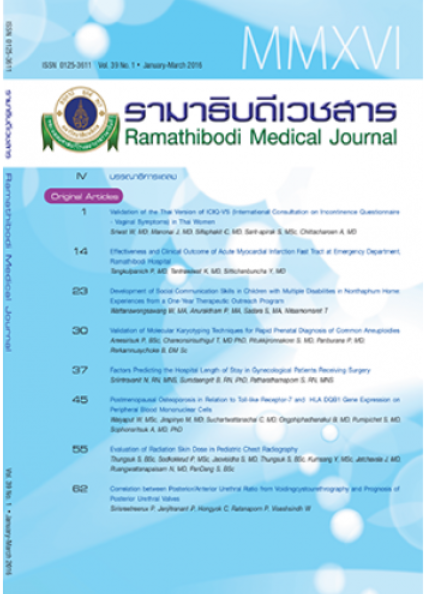Postmenopausal Osteoporosis in Relation to Toll-like Receptor-7 and HLA DQB1 Gene Expression on Peripheral Blood Mononuclear Cells
Main Article Content
Abstract
Background: Data from genome wide association study have demonstrated that the toll-like receptor-7 gene (TLR7), a well-known role in innate immunity, may participate in the development of postmenopausal osteoporosis. The HLA DQB1 gene is part of human leukocyte antigen (HLA) complex. HLA DQB1 plays a critical role in the immune system.
Objective: To determine the association of postmenopausal osteoporosis and transcripts of TLR7 and HLA DQB1 from peripheral blood mononuclear cells (PBMCs).
Methods: The study groups included 25 postmenopausal women with normal bone mineral density (BMD) and the other 25 women with osteoporosis. Blood was drawn from the subjects for bone markers and PBMCs preparation. RNA was then isolated and quantitative RT-PCR was performed for TLR7 and HLA DQB1 genes.
Results: PBMCs expression of both TLR7 and HLA DQB1 were not significantly different between postmenopausal women with normal BMD and those with osteoporosis. (P = 0.567 and P = 0.248, respectively).
Conclusions: It is unlikely that TLR7 and HLA DQB1 contribute a major role on postmenopausal osteoporosis in Thai women.
Article Details
References
Clowes JA, Riggs BL, Khosla S. The role of the immune system in the pathophysiology of osteoporosis. Immunol Rev. 2005;208:207-27.
Kanis JA. Estrogens, the menopause, and osteoporosis. Bone. 1996;19(5 Suppl):185S-190S.
Consensus development conference: diagnosis, prophylaxis, and treatment of osteoporosis. Am J Med. 1993;94(6):646-50.
Takayanagi H. Osteoimmunology: shared mechanisms and crosstalk between the immune and bone systems. Nat Rev Immunol. 2007;7(4):292-304.
Mundy GR. Osteoporosis and inflammation. Nutr Rev. 2007;65(12 Pt 2):S147-51.
Pacifici R. Estrogen, cytokines, and pathogenesis of postmenopausal osteoporosis. J Bone Miner Res. 1996;11(8):1043-51.
Takayanagi H. Mechanistic insight into osteoclast differentiation in osteoimmunology. J Mol Med (Berl). 2005;83(3):170-9.
Asagiri M, Takayanagi H. The molecular understanding of osteoclast differentiation. Bone. 2007;40(2):251-64.
McLean RR. Proinflammatory cytokines and osteoporosis. Curr Osteoporos Rep. 2009;7(4):134-9.
Takeda K, Akira S. Toll-like receptors in innate immunity. Int Immunol. 2005;17(1):1-14.
Goh FG, Midwood KS. Intrinsic danger: activation of Toll-like receptors in rheumatoid arthritis. Rheumatology (Oxford). 2012;51(1):7-23. doi:10.1093/rheumatology/ker257.
Nishimura M, Naito S. Tissue-specific mRNA expression profiles of human toll-like receptors and related genes. Biol Pharm Bull. 2005;28(5):886-92.
Medzhitov R, Janeway C Jr. Innate immunity. N Engl J Med. 2000;343(5):338-44.
Takeda K, Kaisho T, Akira S. Toll-like receptors. Annu Rev Immunol. 2003;21:335-76.
Akashi-Takamura S, Miyake K. TLR accessory molecules. Curr Opin Immunol. 2008;20(4):420-5. doi:10.1016/j.coi.2008.07.001.
Gough SC, Simmonds MJ. The HLA region and autoimmune disease: associations and mechanisms of action. Curr Genomics. 2007;8(7):453-65. doi:10.2174/138920207783591690.
Shiina T, Inoko H, Kulski JK. An update of the HLA genomic region, locus information and disease associations: 2004. Tissue Antigens. 2004;64(6):631-49.
Megiorni F, Pizzuti A. HLA-DQA1 and HLA-DQB1 in Celiac disease predisposition: practical implications of the HLA molecular typing. J Biomed Sci. 2012;19:88. doi:10.1186/1423-0127-19-88.
Thorsby E, Lie BA. HLA associated genetic predisposition to autoimmune diseases: Genes involved and possible mechanisms. Transpl Immunol. 2005;14(3-4):175-82.
Djaafar S, Pierroz DD, Chicheportiche R, Zheng XX, Ferrari SL, Ferrari-Lacraz S. Inhibition of T cell-dependent and RANKL-dependent osteoclastogenic processes associated with high levels of bone mass in interleukin-15 receptor-deficient mice. Arthritis Rheum. 2010;62(11):3300-10. doi:10.1002/art.27645.
Yuan FL, Li X, Lu WG, et al. Regulatory T cells as a potent target for controlling bone loss. Biochem Biophys Res Commun. 2010;402(2):173-6. doi:10.1016/j.bbrc.2010.09.120.
Bradford PG, Gerace KV, Roland RL, Chrzan BG. Estrogen regulation of apoptosis in osteoblasts. Physiol Behav. 2010;99(2):181-5. doi:10.1016/j.physbeh.2009.04.025.
Akira S, Takeda K, Kaisho T. Toll-like receptors: critical proteins linking innate and acquired immunity. Nat Immunol. 2001;2(8):675-80.
Takami M, Kim N, Rho J, Choi Y. Stimulation by toll-like receptors inhibits osteoclast differentiation. J Immunol. 2002;169(3):1516-23.
Johnson GB, Riggs BL, Platt JL. A genetic basis for the "Adonis" phenotype of low adiposity and strong bones. FASEB J. 2004;18(11):1282-4.
Ozkan ZS, Devici D, Yuce H. Investigation of association between TLR4 gene polymorphisms and osteoporosis in postmenauposal Turkish women. Int J Endocrinol Metab. 2012;10(1): 418-22.
Nimitphong H, Saetung S, Ongphiphadhanakul B. Pooled DNA screening of Toll-like receptor gene variants on microarray reveals a variation in Toll-like receptor 7 gene as a susceptibility gene for low bone mass. Program and Abstract of the 91th The Annual Meeting of Endocrine Society; Jun 10-13, 2009; Washington, DC, United States, 2009.
Miyamoto A, Takami M, Matsumoto A, et al. R848, a toll-like receptor 7 agonist, inhibits osteoclast differentiation but not survival or bone-resorbing function of mature osteoclasts. Cytotechnology. 2012;64(3):331-9. doi:10.1007/s10616-012-9442-5.
Douroudis K, Tarassi K, Athanassiades T, et al. HLA alleles as predisposal factors for postmenopausal osteoporosis in a Greek population. Tissue Antigens. 2007;69(6):592-6.
Li SM, Zhou DX, Liu MY. Associations between polymorphisms of HLA-B gene and postmenopausal osteoporosis in Chinese Han population. Int J Immunogenet. 2014;41(4):324-9. doi: 10.1111/iji.12130.
Li SM, Guo H, Yang HJ, Lv MQ, Zhou DX. HLA-A gene polymorphisms contribute to osteoporosis susceptibility in postmenopausal Han Chinese women. Genet Mol Res. 2015;14(3):10322-30. doi:10.4238/2015. August.28.18.
